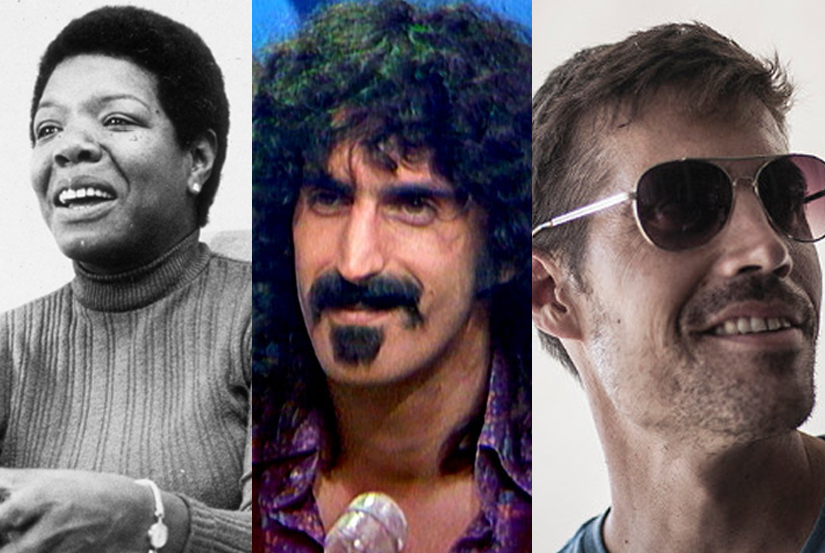
- Festivals
Sundance 2016: Documentaries Explore Art, Pain and High Jinks
Climate change, gun control (or lack thereof), ISIS, women’s rights, gender issues, a privileged socialite’s life, poetry, and music – these were the most timely themes of the documentaries that premiered at the Sundance festival over the past ten days.
There was no shocking doc that had people lining up around five blocks (and not getting in) like last year’s Going Clear: Scientology and the Prison of Belief. But there were certainly a few that stood out, especially the wonderful story of America’s exceptional contemporary author, poet and civil rights activist. Maya Angelou: And Still I Rise, about the icon who died less than a year ago at 86, is the work of co-directors Bob Hercules and Rita Coburn-Whack (who was Angelou’s radio producer and is making her directorial debut). First, brilliance lies in the fact that the filmmakers did not just show the iconic part of her life. They did not shy away from the brutal and often painful back-story that created one of this country’s best writers. The rape of the then seven-year-old girl by her mother’s boyfriend in Arkansas is as openly talked about as the rapist’s murder after the girl tells the police about what happened. Feeling responsible, the girl decides to not speak for the next five years. The vision of a mute Angelou is especially disconcerting while watching the author talk about it in her haunting voice. She finds herself and her voice again by reading poetry and moving to San Francisco where she starts performing and gives birth to her son Guy Johnson, who features prominently in the doc. The film is tinged with emotional moments and features extensive interviews with Angelou, as well as appearances by President Bill Clinton, Hillary Clinton, Quincy Jones, Oprah Winfrey, Cicely Tyson, Common, and Lou Gossett, Jr., among others.
Another high point in the documentary section was Eat That Question, the highly entertaining film about the highly entertaining Frank Zappa. German director Thorsten Schütte got his hands-on footage of rare European TV appearances, interviews, network news reports, bootlegs and philosophical sound bites which amounted to 90 minutes of vintage Frank freak-outs and fun. Ultimately the film gives us the image of an explosively creative, fearsomely talented musician who was also a supremely opinionated rationalist. A contemporary composer who only coincidentally became a counter-culture icon and whose legacy will live on in music.
Speaking of music Spike Lee presented Michael Jackson’s Journey from Motown to Off the Wall, chronicling the superstar’s early days until his breakthrough album. Lee goes to great lengths to get beyond just the appreciation of the young performer’s music and shows what an important figure he was when bridging the chasm that separated most black musicians from reaching mainstream audiences. We may have forgotten how segregated and racist the music business used to be all the way into the 70s, but Lee has not. The director, who previously authored Bad 25, about Jackson’s Bad album, had incredible access to other musicians including Stevie Wonder, to Motown boss Berry Gordy and even to Jackson’s family in order to bring this story to life.
Hollywood and art are celebrated in Norman Lear: Just Another Version of You about the successful TV-producer. With Richard Linklater – Dream is Destiny, directors Louis Black and Karen Bernstein had access to Linklater during most of his film shoots and give the audience a peek into the complicated world of independent filmmaking. Mapplethorpe: Look at the Pictures is about the outrageous life of the scandalous photographer. Becoming Mike Nichols tells the story of the great director from his early and difficult beginnings to the last interviews he gave just before his death.
Werner Herzog dove into the world of the internet with Lo and Behold, Reveries of the Connected World, and Liz Garbus made a documentary on two privileged people in Nothing Left Unsaid: New York socialite Gloria Vanderbilt and her son, CNN anchor Anderson Cooper who both talk about life with a silver spoon from their perspective. To their credit, Garbus and her interview subjects did not gloss over the difficult times when they lost Wyatt Cooper, husband and father early on in Anderson’s life and, most traumatically, the suicide of his older brother Carter who jumped from their 14th floor Manhattan apartment. Most of the audience seemed to be torn between a‚ ‘why should I care about the life of billionaires?’ attitude and‚ ‘this is highly entertaining’ – such as when good old Gloria, now 91 talks about her many sexual high jinks with famous men such as Marlon Brando, Erroll Flynn and Frank Sinatra.
And then there were the uncomfortable docs: Jim, The James Foley Story, directed by a friend of Foley’s, centers on the journalist that was beheaded by ISIS. And Under the Gun is the story of the Sandy Hook elementary school shooting told through the eyes of the victims’ families and pro-gun advocates.
All in all, it was another good year for Sundance documentary premieres, some of which might just show up on the list of Oscar nominations in 2017.

